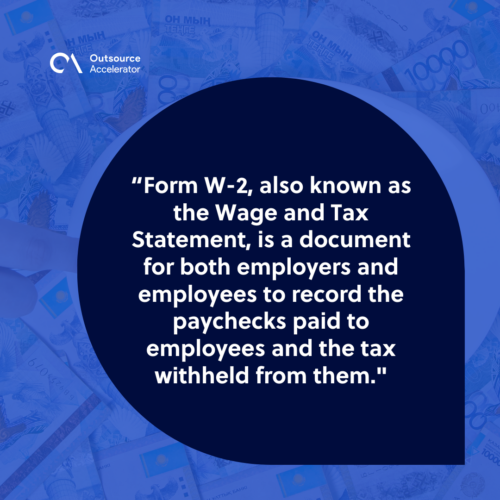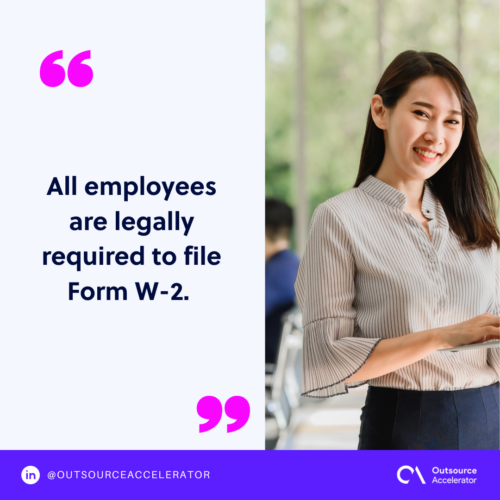What you need to know about Form W-2

The government requires companies to pay their share of taxes from their employees’ salaries.
When you have a lot of employees and tax-related fees to keep track of, the official document to help you record all of them is Form W-2.
Continue reading to learn more about the purpose of this form and how to file it properly.
What is Form W-2?
Form W-2, also known as the Wage and Tax Statement, is a document for both employers and employees to record the paychecks paid to employees and the tax withheld from them.
This form must be provided annually to the IRS, and employees file it to keep track of their income tax return.
In addition to federal or state taxes, Form W-2 reports employer fringe benefits, such as medical insurance and dependent care assistance.
Form W-2 is due on or before January 31 each year, giving each employee enough time to file income taxes for the previous year.

Parts of Form W-2
A W-2 form is the same for every employee. It is divided into two federal and state sections since taxes need to be filed for both.
On the form, you will find the employer’s information, such as their Employee Identification Number and state ID number.
On the employee’s side, you will find spaces where you can list down their total earnings for that year. You will also find the amount of withheld taxes from their paycheck.
The amount of tax withheld is deduced from their gross tax obligation. A refund will be issued if an excess amount of tax is withheld.
Additionally, if your employee receives tips from their job, you will find the field that shows how much they received in tips throughout the year.
Who needs to file Form W-2?
All employees are legally required to file Form W-2. One W-2 form must be filed for every employee who is paid wage, salary, or other compensation.
Employees may receive multiple W-2 forms if:
- They changed jobs within the calendar year
- They work more than one job as an employee
- The company was acquired by another company

Filling out Form W-2
In order to properly file your Form W-2, you need to understand the different lettered and numbered sections of the form itself.
The lettered boxes (labeled A through F) ask for the employer and employee’s basic information. This includes the employee’s name, address, ZIP code, and social security number.
On the employer’s side, it will require their name, address, ZIP code, Employer Identification Number, and control number.
After filling out the lettered boxes, you can proceed to the numbered boxes, which ask for details about your wages and taxes.
- Box 1 – Employee’s wages, tips, and bonuses
- Box 2 – How much federal income tax is withheld from the employee’s pay
- Box 3 – How much pay in Box 1 is subject to Social Security tax
- Box 4 – Amount of withheld Social Security tax
- Box 5 – How much pay in Box 1 is subject to Medicare tax
- Box 6 – Amount withheld from Medicare tax
- Box 7 – How much the employee reported in tips
- Box 8 – How much tips the employer allocated to the employee
- Box 9 – Now-defunct tax perk
- Box 10 – Amount of dependent care benefits
- Box 11 – The amount distributed to the employee from the employer’s deferred compensation plan
- Box 12 – Lists other types of compensation or reductions from income
- Box 13 – The three boxes indicate earnings not subject to federal income tax, such as retirement benefits or sick pay
- Box 14 – Any additional information that is not applicable to the other sections
- Boxes 15-20 – Used to report state and local income tax information, including:
- How much of the employee’s pay is subject to state income tax
- How much state income tax is withheld from pay
- How much is subject to local income tax
- How much local tax is withheld from pay
How to get Form W-2?
Employees receive their Form W-2 by mid-February sent by their employers to their addresses.
Workers may also ask their employers to send an online copy from the HR department or payroll provider.
If they cannot access the form online or have not received it from their employer in time, they may contact their HR department for a follow-up.
Ensuring tax compliance with Form W-2
Form W-2 is essential to ensure businesses stay compliant with federal tax regulations.

It details important information on an individual’s earnings, taxes withheld, and other necessary details concerning their wages or compensation.
Businesses need to stay updated on any updates or changes regarding tax laws and deadlines. Doing so will allow you to adjust accordingly and log their tax information completely and accurately.







 Independent
Independent




